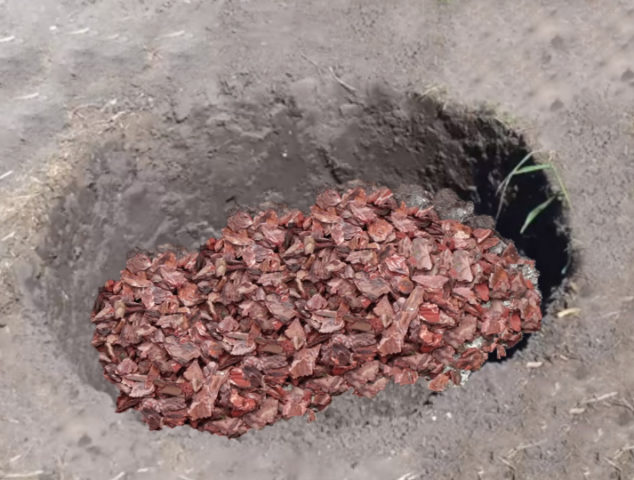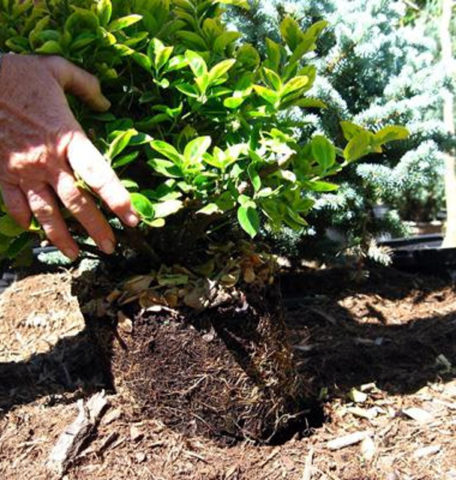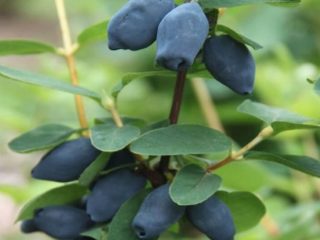Content
Honeysuckle Serotina is a common variety that belongs to the climbing honeysuckle species (Lonicera periclymenum), and is a beautiful flowering vine. The culture is intended for decorative landscaping; it wraps around any proposed supports.
Description of honeysuckle Serotina
Honeysuckle Serotina is a perennial climbing deciduous shrub. Belongs to late varieties. It reaches a height of 4 m, is distinguished by rapid growth, the stems increase annually to 1 m. The shoots of the first year are bare or with weak pubescence. The leaves are located opposite, have an ovoid shape, the size is about 6 cm. The color is dark green above and gray-bluish below. The foliage is dense.
The shrub is valued for its abundant and elegant flowering. The flowers are two-lipped, bisexual, collected in dense inflorescences with long stamens. They are painted in several shades - white-cream in the center and purple on the outside. After flowering they become paler.

Flowering occurs at the tops of the current year's shoots
Decorative honeysuckle Serotina blooms throughout the entire season - from June until the cold weather. You can prolong flowering if you promptly pick off fading inflorescences and prevent the appearance of fruits. The flowers are very fragrant, reminiscent of the aroma of linden honey, which becomes more intense in the evening.
Lianas begin to bloom at the age of 3-4 years. Decorative fruits of the bush are round berries of bright red color, 1 to 2 cm in diameter, appear from August to October. They are not eaten.
In cold regions, it should be taken into account that vines must be removed for shelter in the winter. It is more convenient to do this together with a support if it is not metal. Lianas can also be cut and the bush can be given various shapes.
Honeysuckle Serotina is resistant to diseases and pests, which makes caring for the crop easier.
Winter hardiness of seaside honeysuckle Serotina
The frost resistance of seaside honeysuckle Serotina belongs to zones 5B-9. Withstands winter temperatures down to -28.8°C. In the middle zone it requires shelter. When the stems freeze in the new season, the plant quickly recovers. The decorative effect is maintained by flowering on new shoots.
Planting and caring for honeysuckle Serotina
For planting, take a seedling with an open or closed root system. A healthy plant has glossy green leaves, evenly colored, strong and straight stems. The roots are inspected and any dry or damaged ones are removed.To reduce stress from replanting and more quickly adapt the plant to a new growing location, the root system is soaked in a rooting solution, for example, “Kornevin”, before planting.
Landing dates
Honeysuckle Serotina is planted in late summer - early autumn. In spring, plants wake up early, and it is easy to miss the moment of planting. Seedlings with a closed root system can be planted throughout the warm season.
Selection and preparation of a landing site
Honeysuckle Serotina is unpretentious to soil conditions. But in areas where the soil dries out quickly, or in lowlands, it is better not to plant it. The shrub will develop well in well-drained, light and fertile soils. Acidity is preferably neutral, but slightly acidic is also acceptable.
The planting area should be sunny. The culture tolerates slight temporary shading. In full shade, the flowers become small or do not appear at all. Lianas also need to be protected from drafts and sharp cold gusts of wind.
The root system of the plant does not extend far into the soil, so digging the soil at the planting site is done shallowly. It is loosened at the planting site and weeds are removed.
Landing rules
For planting, depending on the number of plants being planted, an individual planting hole or trench is dug. The depth is 25-30 cm, the diameter of the planting area for one shrub is about 40 cm. If you plan to grow honeysuckle as a ground cover plant, the distance between individual seedlings is about 1.5 m. When growing vertically, the plants are planted at a distance of 2 m.
Boarding order:
- The planting pit is prepared two days before transplantation.
The size of the hole depends on the age of the seedling and the volume of its earthen coma
- A drainage layer is placed at the bottom of the hole.
Expanded clay, pebbles or a layer of sand can serve as drainage
- Fertilizer is applied and mixed with soil.
For each plant add about 10 kg of rotted manure or compost, 100 g of superphosphate and 50 g of potassium salt
- In the planting hole, the seedling is placed vertically, covered with a layer of soil and lightly crushed.
The plant is planted without deepening, at the same level as it grew before
After transplanting, the branches are lightly pruned to balance the underground and above-ground parts. A mulch layer is applied to the soil.
Watering and fertilizing
Serotina honeysuckle is watered regularly, but in moderation. When growing shrubs, it is important not to allow the soil to dry out completely. To do this, mulch the soil around the plant; do not grow bushes next to aggressive crops that take up a lot of moisture.
Fertilizers begin to be applied from the second year after planting. The shrub is responsive to both complex and organic compounds. For highly acidified soil, add lime once every four years.
Pruning honeysuckle Serotina
Honeysuckle Serotina tolerates shaping well and quickly increases the vegetative mass. Thanks to pruning, the density of flowering is also regulated. Without shaping, the bush quickly fills the space and may look unkempt.
Due to the fact that in honeysuckle it is difficult to distinguish between living and damaged shoots before the leaves appear, pruning of stems damaged during winter is carried out only after the plants begin to grow.
Rejuvenating and thinning pruning is done once every 2-3 years in the autumn, after the plant has shed its leaves. During this period, old and small shoots are removed.

Anti-aging pruning is necessary to prevent a decrease in the size of leaves and the number of flowers
The plant is left with strong main shoots, which are given the desired direction, and the tops are trimmed. For bushes older than six years, sanitary pruning is carried out and dried, broken stems are removed.
When growing honeysuckle Serotina as a ground cover, the stems are trimmed to the required length. So the culture acts as a kind of lawn. When grown on an alpine hill, the shoots are directed from top to bottom.
Wintering
The base and soil around the bush are mulched with dry leaves for the winter. The stems of honeysuckle Serotina in the middle zone also need to be covered. To do this, they are laid horizontally on the soil. When removed from the support, the stems can be injured, so it is best to lay them together. The plants are placed not on bare ground, but on a litter of spruce branches, then pinned and covered with non-woven material.
Mulch and cover are removed in the spring, after the risk of frost returns has passed. Removal of protective materials is carried out on a cloudy day so as not to expose the plants to sunburn.
Reproduction of climbing honeysuckle Serotina
Honeysuckle Serotina is propagated by seed and vegetative methods. Growing from seeds is the longest option. Flowering with this method of propagation begins only in the fifth year.
Honeysuckle is well cut, planting material is cut from the current year's shoots 12-15 cm long. Then it is grown in planting containers at a temperature of +20°C.

Cuttings have a high percentage of rooting
The simplest method of propagation is the layering method. In this case, seedlings are grown without being separated from the main plant. To do this, select the required number of strong shoots. A shallow ditch is dug nearby, the shoot is placed horizontally in it and covered with soil.

For better fixation, the shoot is pressed with hooks or staples
After rooting, the new plant is separated from the mother plant and transplanted to the desired location.
Pollinators of honeysuckle Serotina
Unlike honeysuckle, which has edible fruits, the ornamental shrub does not need pollinators. The flowers of the plant are bisexual, so Serotina honeysuckle can be planted singly. But with cross-pollination in group planting, more flowers appear.
Diseases and pests
Serotina honeysuckle is little susceptible to diseases and pests. During prolonged rainy weather and a thickened bush, a fungal infection - powdery mildew - may occur on it. In this case, spraying is carried out with copper-containing preparations.
When the vegetative mass of a plant is damaged by various types of aphids, spraying with an infusion of chamomile and soap is used.
Conclusion
Honeysuckle Serotina is a climbing flowering shrub that is highly adaptable to soil conditions. The crop is grown separately and together with other species or varieties to create picturesque hedges and decorate the walls of gazebos and buildings.













